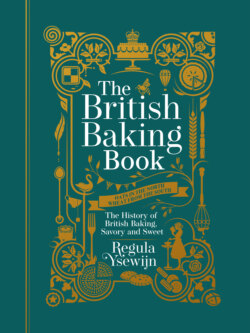Читать книгу The British Baking Book - Regula Ysewijn - Страница 13
На сайте Литреса книга снята с продажи.
Оглавление16
INGREDIENTS
I think that when baking, and when cooking in general, the rule should be that you have to use the best ingredients to get the best
results. Budgets for food differ, of course, but I prefer to eat less cake and make it the best cake I can afford. That means that I am
always looking for fresh flour from a good source. Flour that’s left unused for many months will become dry and that will affect your
baking. Preferably buy all organic ingredients. For example, I buy only organic eggs or eggs straight from the farm. Firstly, because
I think it is not right that we keep hens in confined barns where they never see the light of day and can never roam freely. Secondly,
because an egg from a chicken that has had the space to live and breathe has much more flavor. So you can decide why you choose
organic eggs – is it because you say no to animals suffering for your dinner, or because you simply want the best eggs? The two are
naturally connected. That, of course, also applies to meat; good provenance ensures good taste.
Flour
I think it’s important that you understand why I ask you to use a certain flour, because the protein content of flour has an influence
on your results. The higher the protein content of your flour, the more elasticity your dough will get. A flour with a high protein
content is therefore good for bread and other pastries that are supposed to be light or would benefit from a little elasticity. Unlike
white flour, 100 percent whole-wheat flour is brown because it is made from the entire grain and still contains bran. It therefore
also contains fiber and vitamins that are no longer present in white flour. Wheat is the most common cereal used for whole-grain
flour, but it can also be made from rye, spelt, oats, and barley, as well as a lot of other rare, ancient, or less-common crops.
Strong white bread flour – around 12.6 g (½ oz) of protein per 100 g (3½ oz) of flour (12–13%)
British recipes for bread and other bakes sometimes require completely or partially strong white bread flour, which can be compared
to patent flour. This flour is made from harder wheat, which means that the flour contains more gluten. Gluten is needed for a light
and well-raised result. There are several varieties of patent flour and the difference is in the protein content. French flour, which
has the designation T65, usually contains 13 g (½ oz) of protein. American flour may be made from either winter or summer wheat.
Winter wheat is sown in the fall and harvested in the summer. This wheat produces more protein than wheat that grows in the
summer. These types of flour are available only in specialty shops or online, but are very accessible to hobby bakers.
Plain white flour – around 10 g (¼ oz) of protein per 100 g (3½ oz) of flour (10%)
Recipes for more delicate bakes use what the British call “plain white flour.” Where I live in Flanders, close to Holland, we have
Zeeland flour, made from soft wheat that grows in a maritime climate. Zeeland flour has a low protein content of 10% and will
therefore develop little gluten. It’s ideal for brittle cookies such as shortbread and short dough for shortcrust cake bases. Your local
area may have a flour that is similarly low in protein, or you can choose the regular all-purpose flour you can get everywhere.
Oats
There are many varieties of oatmeal and oat flakes:
Rolled oats, also called old-fashioned, are made by steaming whole oat groats, then running them between rollers to make flat
flakes. The steaming partially cooks the oats, which makes them cook faster when you use them in your cooking. Rolled oats are
sold in the traditional size and also as jumbo oats.
Steel-cut oats, also called “pinhead oats,” are whole oats that have been cut into two or three pinhead-sized pieces. Steel-cut oats
are also used for porridge, and are considered the Irish way of making porridge. They have more bite and a nuttier flavor.
Porridge oats, or oatmeal, are made by grinding steel-cut oats or rolled oats about halfway to flour, leaving lots of coarse pieces.
They come in a fine, medium, or coarse variety. In the United States, look for porridge oats online, or substitute quick-cooking oats.
Oat flour is a much finer substance than oatmeal. It is ground from whole oat groats, steel-cut oats, or rolled oats. It’s completely
soft and resembles whole-grain flour. You can create oat flour by grinding rolled oats with the blade attachment of a food processor.
